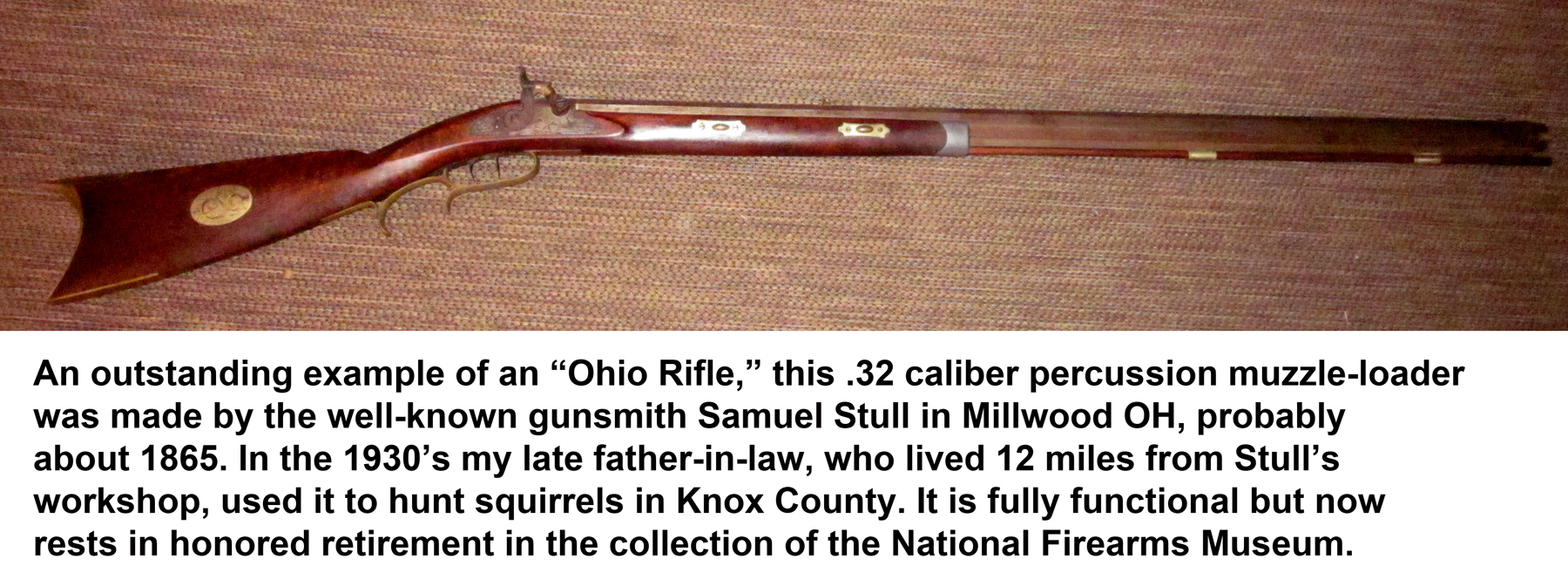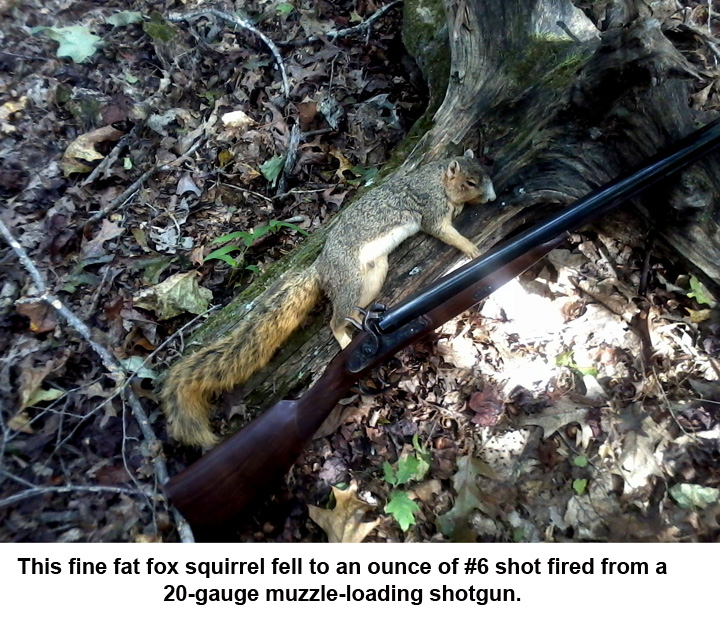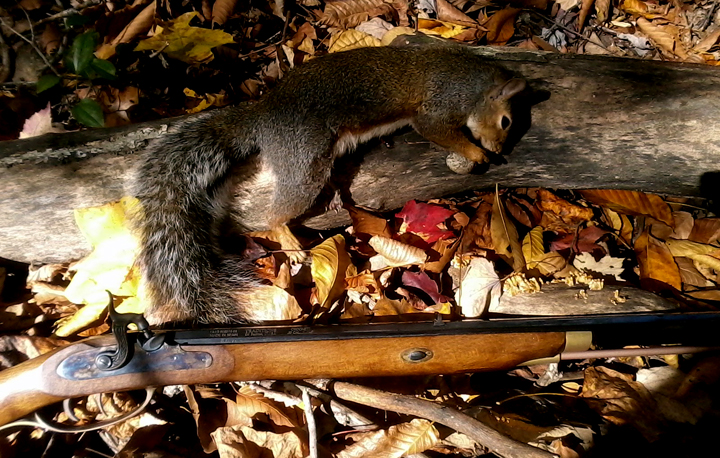

As is the case with many other hunters in Virginia, I hunt deer with a muzzle-loading rifle. I began doing so some 25 years ago when the Commonwealth established a special season and in the intervening years I've taken many whitetails with one. Some time ago I decided to embrace the additional challenge of hunting small game “the old-fashioned way.” Doing so added many pleasant hours in the woods, and when you come right down to it, in the final analysis hunting is hunting, regardless of method or quarry. Beginning to think that hunting small game with a shotgun or a .22 rifle was sometimes "too easy,” I was ready to play by a different set of rules. The decision brought me much satisfaction, and perhaps a better understanding of the world in which the pioneers lived, and how they dealt with it.
For our forebears game meat was the principal source of protein. Small animals were at least as important in their dietary as large game because they were abundant, readily obtained, and very easy to hunt just by stepping out the door of the cabin. Moreover small game provided “basic training” in woodcraft and hunting skills for youngsters, while also allowing them to contribute to the family larder. There’s a legend that Davy Crockett’s first hunt was for squirrels, and that instead of a lead bullet, he used hard, dried peas! Considering the cost of lead in the frontier wilderness of 18th Century North America, maybe that isn’t just a legend.
 What certainly isn’t a legend is that Davy’s first hunt was for squirrels. In frontier times squirrels were fantastically abundant and arguably, if it weren’t for squirrels, most of the southeastern parts of North America would never have been settled at all. Over the course of eons nut-burying squirrels planted the vast hardwood forests that blanketed the continent. In Colonial times a squirrel could travel from Maine to the Mississippi River without ever touching ground, and 25% of that virgin forest consisted of chestnut trees, a reliable and unlimited food supply. Many reliable eyewitness reports exist of the phenomenal abundance of squirrels in the 17th, 18th, and early 19th Centuries.
What certainly isn’t a legend is that Davy’s first hunt was for squirrels. In frontier times squirrels were fantastically abundant and arguably, if it weren’t for squirrels, most of the southeastern parts of North America would never have been settled at all. Over the course of eons nut-burying squirrels planted the vast hardwood forests that blanketed the continent. In Colonial times a squirrel could travel from Maine to the Mississippi River without ever touching ground, and 25% of that virgin forest consisted of chestnut trees, a reliable and unlimited food supply. Many reliable eyewitness reports exist of the phenomenal abundance of squirrels in the 17th, 18th, and early 19th Centuries.
One reference from the Columbus (Ohio) Gazette from August 29, 1822, describes a 3 day hunt in Franklin County in which 19,660 squirrels were killed. A 1918 paper in the National Geographic Society Journal remarks that:
During the early settlement of the country...west of the coast, gray squirrels existed in great numbers...In 1749 they invaded Pennsylvania in such hosts that a bounty of three pence each was put on their scalps. Eight thousand pounds sterling was paid on this account, which involved the killing of 640,000 squirrels. In 1808 a law in force in Ohio required that each free white male deliver 100 squirrel scalps a year….
Today, while nowhere near their original levels, small game populations in most areas are at sustainable, huntable numbers, giving hunters the chance to know the satisfaction of a good stalk and a clean shot on small targets with a primitive weapon.
The “Kentucky” hunting rifle was typically about .40 caliber, adequate for any animals in eastern woodlands, large and small, with four legs or two. Small bullets conserved powder and lead, both of which were scarce and valuable because every ounce had to be carried over the mountains from the coast into a howling wilderness with few roads. One tactic for killing squirrels that also preserved lead was "barking" them. “Barking" squirrels preserved lead because the bullet could be dug out of the tree limb and melted down for re-use. John James Audubon described how this was done by none other than Daniel Boone:
Barking of squirrels… requires a [great]…degree of accuracy...I first witnessed this manner of procuring squirrels [by] the celebrated Daniel Boone...He raised his piece..the whip like report resounded through the woods...Judge of my surprise when I perceived that the ball had hit the piece of bark immediately beneath the squirrel and shivered it into splinters, the concussion produced by which...killed the animal and sent it whirling through the air as if it had been blown up by the explosion of a powder magazine.
While it was very much the frontier in the 18th Century, by the mid-19th, in Ohio large animals had disappeared. People in such long-settled areas came to favor very accurate small caliber so-called “Ohio Rifles” for small game and recreational shooting. Many originals survive as family treasures, or in private collections and museums but an original gun isn’t the best choice for hunting. After a couple of hundred years—especially considering the hard use to which these guns often were put—most of them are worn to the point where their real value is as collector’s pieces or family heirlooms.

Fortunately good quality small-caliber replica rifles—almost always traditional style sidelocks—are now made. These reasonably authentic and easily affordable mass production guns can be had with your choice of percussion or flint locks. Set triggers and traditional sights, common on the originals, are standard features of the reproductions as well.
 Muzzle-loading rifles for small game should be between .32 and .36 caliber, with the smaller caliber probably more common. A .32 is fine for squirrels and rabbits while the larger .36 is more effective on raccoons, groundhogs, or coyotes. The preferred projectile is a patched round ball. Balls are accurate and perform well; a .32 caliber ball weighs 45 grains, the .36 weighs 65 grains, comparable to bullets used in cartridge rifles. Balls and powder are readily available from commercial sources; or you can cast your own bullets easily. The small charges of black powder used provide a lot of fun and fine shooting at low cost.
Muzzle-loading rifles for small game should be between .32 and .36 caliber, with the smaller caliber probably more common. A .32 is fine for squirrels and rabbits while the larger .36 is more effective on raccoons, groundhogs, or coyotes. The preferred projectile is a patched round ball. Balls are accurate and perform well; a .32 caliber ball weighs 45 grains, the .36 weighs 65 grains, comparable to bullets used in cartridge rifles. Balls and powder are readily available from commercial sources; or you can cast your own bullets easily. The small charges of black powder used provide a lot of fun and fine shooting at low cost.
Accuracy matters when hunting small animals, so how accurate are small caliber muzzle-loaders? Quite adequately so: in the hands of a competent marksman, a good mass-production gun is easily capable of 5-shot groups the size of a dime at 25 yards. That’s smaller than a squirrel’s head. Instead of being cut-rifled one groove at a time as in the past, new-made barrels are button rifled or hammer forged, leading to greater uniformity and accuracy, as well as reduced production costs. Locks sometimes use coil rather than flat leaf springs, resulting in faster lock time and enhanced durability. Other factors contributing to accuracy are minimal recoil and noise, as well as "set" triggers that provide a very light let-off.
Traditional style guns had open iron sights: only rarely are small caliber sidelock muzzle-loaders even capable of mounting a telescopic sight. This isn’t a big deal: at the short ranges of small game hunts (usually well under 50 yards) iron sights are more than adequate. A peep sight is better than open sights, and some companies offer after-market peep sights that can easily be installed.
 I soon branched out to muzzle-loading shotguns as another option. World-wide, shotguns are far more commonly used on game than rifles because their inherent flexibility suits them for any kind of game, large or small, furred or feathered. The Colonial militiaman’s smooth-bored musket wasn’t functionally much different from a better-heeled settler’s “fowling piece.”
I soon branched out to muzzle-loading shotguns as another option. World-wide, shotguns are far more commonly used on game than rifles because their inherent flexibility suits them for any kind of game, large or small, furred or feathered. The Colonial militiaman’s smooth-bored musket wasn’t functionally much different from a better-heeled settler’s “fowling piece.”
Don’t shoot an original gun, even if you have one! The very high quality muzzle-loading shotguns made today mean there is no need to risk using an original gun's “Damascus” barrel, which by virtue of its method of manufacture is prone to developing invisible weak spots. If you have an original hang it on the wall to admire: a replica will cost you less than the co-pay for getting your fingers sewn back in place. Additionally the new-made shotguns are far stronger and most of them are capable of handling the non-toxic shot required in many localities.


Almost all double-barreled muzzle-loading shotguns have external hammers and detachable conventional sidelocks. Some have “back action locks,” a common 19th Century design. Gauge nomenclature is identical to that of breech-loaders. While all manufacturers who produce muzzle-loading shotguns make a 12-gauge, some make a 20-gauge, and one or two make 10-gauge guns. The 16 gauge is quite rare, and so far as I’ve been able tell, no .410 bore muzzle-loading shotgun is mass-manufactured.
 A lightweight 20-gauge muzzle-loading shotgun is a delightful thing to use in the woods; the larger 12 gauge is well suited for upland bird hunting. Some modern black powder shotguns are cylinder bored, some are choked, and at least one make uses screw-in choke tubes. Choke becomes an issue only when it’s tight enough to hamper insertion and ramming of the wads. It can be nearly impossible to insert a wad through a FULL choke, but if the gun has removable tubes, the tube can be removed, the gun loaded and the tube (carefully) screwed back in.
A lightweight 20-gauge muzzle-loading shotgun is a delightful thing to use in the woods; the larger 12 gauge is well suited for upland bird hunting. Some modern black powder shotguns are cylinder bored, some are choked, and at least one make uses screw-in choke tubes. Choke becomes an issue only when it’s tight enough to hamper insertion and ramming of the wads. It can be nearly impossible to insert a wad through a FULL choke, but if the gun has removable tubes, the tube can be removed, the gun loaded and the tube (carefully) screwed back in.
Generally speaking black powder shotguns more closely match the performance of breech loaders than do rifles. The only real caveat is that with loose fiber wads you can expect somewhat more open patterns and slightly reduced effective range. But in terms of the energy of the pellets that depends on their velocity, and the velocity depends on the powder charge. A lead pellet propelled by black powder at X feet per second has exactly the same energy as one propelled at that same velocity by smokeless powder, and will be just as effective, all other things being equal.
In the field the hunter can adjust powder charge and shot weight on the spot, giving him the flexibility to tailor his charge to the needs of the moment. Most authorities advise using a "square" load, i.e., one in which the volume of powder is equal to the volume of shot. Because volumetric measurements are less precise and less repeatable than gravimetric ones, I prefer to weigh out and pre-measure my charges at home, carrying them with me in my possibles bag.

As in Colonial days, the small-caliber muzzle-loader is ideal for introducing new shooters to the sport. The rifles have very little noise and flash and minimal recoil. Shotgun loads can be reduced on the spot to accommodate a novice who may be recoil-sensitive. The slow process of reloading is not a drawback, rather the reverse. It teaches the new hunter patience and fire discipline. Knowing there is usually only one opportunity will produce a better, more careful hunter who’s willing to wait for the perfect opportunity. If slow reloading translates into fewer shots, it also means a higher success  rate for those you choose to take.
rate for those you choose to take.
This very charming portrait is in Vienna’s Belvedere Museum: it's titled Joseph Strommer as a Hunter. It shows a typical rig for the mid-19th Century sportsman. With the possible exception of his rather flamboyant hat, a today’s muzzle-loading hunter can easily duplicate all the items of his equipment with new-production equivalents. He has a double-barrel gun with outside hammers. Over his right shoulder he has slung a “shot snake” equipped with a built-in measuring spout that hangs next to his left hip so he can select just as much shot he wants. From his right shoulder also hangs a bottle-shaped powder flask of copper or leather, with an adjustable dispenser. In his pockets or in the “possibles bag” peeping out from behind his right hip, he carries a capper, plus as many wads of several types as he thinks he needs for the day’s shoot. A ramrod is slipped through thimbles under and between the gun’s barrels. He’s ready for anything. Are you?
| HUNTING | GUNS | DOGS |
| FISHING & BOATING | TRIP REPORTS | MISCELLANEOUS ESSAYS |
| CONTRIBUTIONS FROM OTHER WRITERS|
| RECIPES |POLITICS |